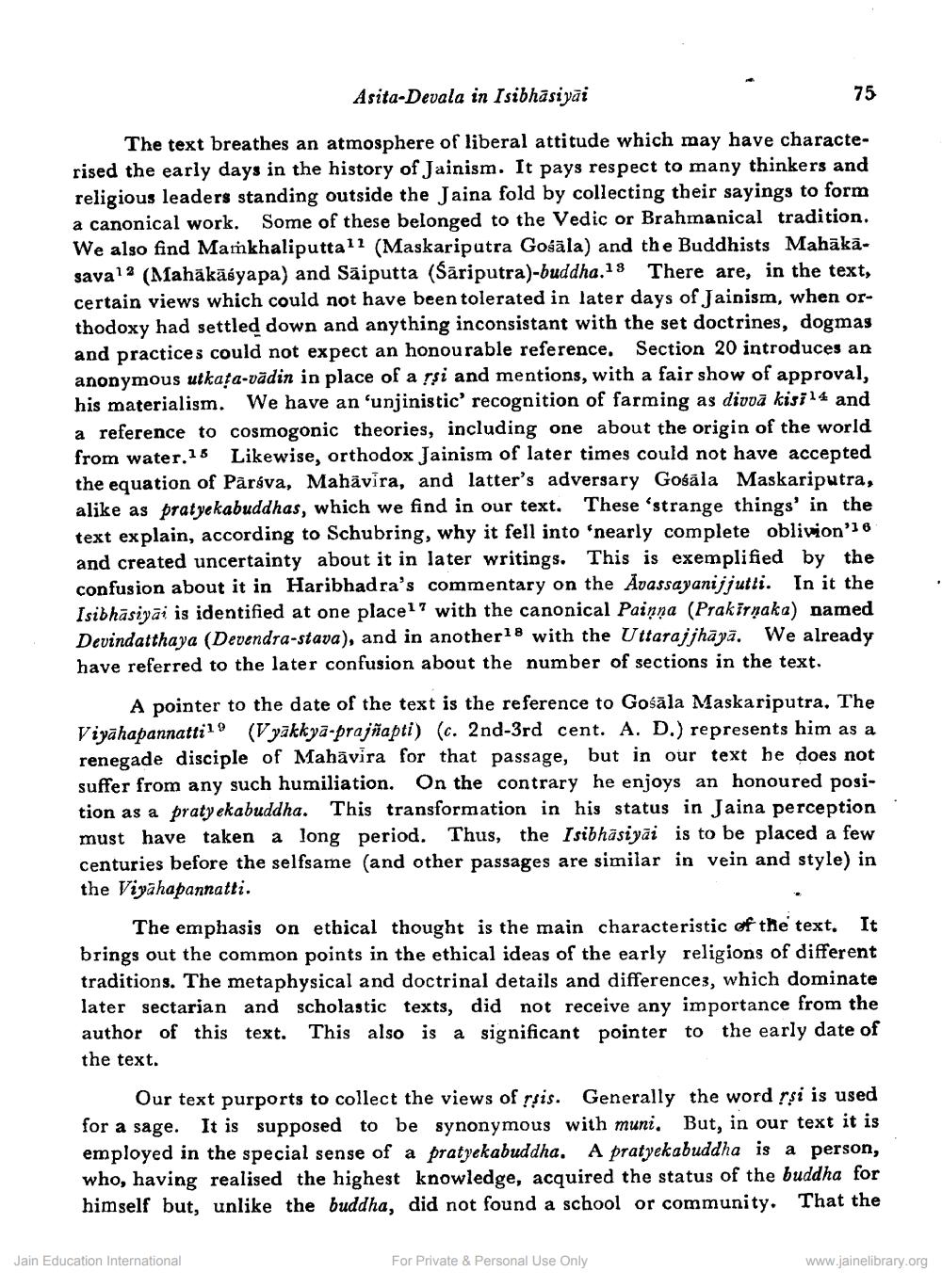Book Title: Asita Deval in Isibhasiyai Author(s): Lallan Gopal Publisher: Z_Aspect_of_Jainology_Part_3_Pundit_Dalsukh_Malvaniya_012017.pdf View full book textPage 2
________________ Asita-Devala in Isibha siyai 75 The text breathes an atmosphere of liberal attitude which may have characterised the early days in the history of Jainism. It pays respect to many thinkers and religious leaders standing outside the Jaina fold by collecting their sayings to form a canonical work. Some of these belonged to the Vedic or Brahmanical tradition. We also find Mamkhaliputta11 (Maskariputra Gośäla) and the Buddhists Mahākāsaval? (Mahākāsyapa) and Sāiputta (Sāriputra)-buddha.13 There are, in the text, certain views which could not have been tolerated in later days of Jainism, when orthodoxy had settled down and anything inconsistant with the set doctrines, dogmas and practices could not expect an honourable reference. Section 20 introduces an anonymous utkata-vādin in place of a sși and mentions, with a fair show of approval, his materialism. We have an 'unjinistic' recognition of farming as divvā kisi 14 and a reference to cosmogonic theories, including one about the origin of the world from water. 15 Likewise, orthodox Jainism of later times could not have accepted the equation of Paráva, Mahāvira, and latter's adversary Gośāla Maskariputra, alike as pratyekabuddhas, which we find in our text. These 'strange things in the text explain, according to Schubring, why it fell into 'nearly complete oblivion'16 and created uncertainty about it in later writings. This is exemplified by the confusion about it in Haribhadra's commentary on the Avassayanijjutti. In it the Isibhāsiyai is identified at one place17 with the canonical Paiņņa (Prakirņaka) named Devindatthaya (Devendra-stava), and in another18 with the Uttarajjhāyā. We already have referred to the later confusion about the number of sections in the text. A pointer to the date of the text is the reference to Gośāla Maskariputra. The Viyahapannatti19 (V yakkyā-prajñapti) (c. 2nd 3rd cent. A. D.) represents him as a renegade disciple of Mahāvira for that passage, but in our text he does not suffer from any such humiliation. On the contrary he enjoys an honoured position as a praty ekabuddha. This transformation in his status in Jaina perception must have taken a long period. Thus, the Isibhasiyāi is to be placed a few centuries before the selfsame (and other passages are similar in vein and style) in the Viyahapannatti. The emphasis on ethical thought is the main characteristic of the text. It brings out the common points in the ethical ideas of the early religions of different traditions. The metaphysical and doctrinal details and differences, which dominate later sectarian and scholastic texts, did not receive any importance from the author of this text. This also is a significant pointer to the early date of the text. Our text purports to collect the views of rşis. Generally the word rsi is used for a sage. It is supposed to be synonymous with muni. But, in our text it is employed in the special sense of a pratyekabuddha. A pratyekabuddha is a person, who, having realised the highest knowledge, acquired the status of the buddha for himself but, unlike the buddha, did not found a school or community. That the Jain Education International For Private & Personal Use Only www.jainelibrary.orgPage Navigation
1 2 3 4 5 6 7 8 9 10 11 12 13 14
